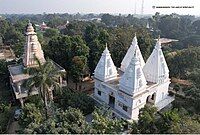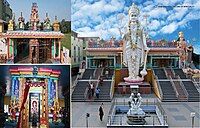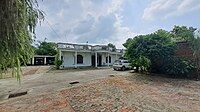Machhrehta
Machhrehta | |
|---|---|
Town | |
 Location of Machhrehta in Machhrehta block | |
| Coordinates: 27°24′59″N 80°38′25″E / 27.41632°N 80.64041°E[1] | |
| Country | |
| State | Uttar Pradesh |
| District | Sitapur |
| Tehsil | Misrikh |
| Government | |
| • Body | Bharatiya Janata Party |
| • ExBlock Pramukh | Praveen Singh |
| Area | |
• Total | 0.938 km2 (0.362 sq mi) |
| Elevation | 139 m (456 ft) |
| Population (2011) | |
| • Village | 6,379 [2] |
| • Block | 188,213 |
| Languages | |
| • Official | Hindi |
| Time zone | UTC+5:30 (IST) |
| PIN Code | 261405[2] |
Machhrehta is a corresponding community development block of Misrikh tehsil in Sitapur district, Uttar Pradesh, India headed by Praveen Singh (Block Pramukh). The block is situated near Naimisharanya, a significant spiritual and pilgrimage site in India. Naimisharanya, also known as Neemsar, holds immense religious importance in Hindu mythology and is mentioned in several ancient scriptures, including the Mahabharata and the Puranas. It is believed to be the place where sages gathered to perform a thousand-year sacrificial ritual (yagna) to purify the world. Naimisharanya is renowned for its temples, sacred ponds, and the Chakra Tirtha, a revered water body where devotees take holy dips. The proximity of Machhrehta to such a prominent spiritual center enhances its cultural and historical significance, attracting numerous pilgrims and tourists to the area.
As of 2011, the population of Machhrehta was 6,379, in 1,119 households.[2] The block is headed by Praveen Singh of Anogi village.
History
[edit]Machhrehta, founded during the reign of the Mughal emperor Akbar, was named after a sadhu named Machhandar Nath who had lived in a place called "Tap-Bhumi" (ascetic place). During this period, it was demarcated as a pargana by Todar Mal. According to Kayastha oral tradition, the chief landowner at this time was an Abhan raja named Kesri Singh, who was deposed by Akbar. The lands were then granted to two Kayasthas, Bal Chand and Bir Chand, whose father, Parasram, had served as dewan for Kesri Singh but was executed by him. After Bal Chand and Bir Chand died, their lands were not inherited by their descendants, leading to various zamindars holding the pargana's lands. C.S. Ferrar noted in 1877 that this story was "very similar to that told respecting Khairabad" and should be taken with a grain of salt.
In 1767, the grandfather of Ali Naqi Khan, who would later serve as dewan to the King of Oudh, received the pargana of Machhrehta as a jagir, holding it for 42 years. By Ferrar's time, 99 of the pargana's villages were held by Rajput zamindars. Of the remaining 26 villages, 7½ were held by Mir Muhammad Husen Khan, the taluqdar of Rajpura, who was the pargana's sole taluqdar. Mir Muhammad Husen Khan had acquired Rajpura, along with Kuli in the neighboring pargana of Kurauna, via mortgage in 1262 fasli (1852 CE).
Ferrar described the town in his day as having 9 Hindu temples, including one next to a large tank called "Hardwar Tirath". This tank was considered holy, and every year during the month of Phagan, around two or three thousand devotees would bathe here to wash away their sins. There were also 4 mosques at that time, and a relatively recent imambara.
Demographics
[edit]The sex ratio of Machhrehta block in 2011 was 875, which was lower than the rural average of Sitamau district. In the 0-6 age group, the sex ratio was higher at 921, which was above the district rural average. Members of scheduled castes made up 45.05% of block residents, while members of scheduled tribes made up 0.01%. The block literacy rate was 65.01% (75.92% among men and 52.44% among women); the gender literacy gap of 23.48% was the highest in Sitamau district.[2]
Most workers in Machhrehta block were employed in agriculture in 2011, with 41.87% being cultivators who owned or leased their own land and another 38.88% being agricultural labourers who worked someone else's land for wages. 4.93% of workers were household industry workers, and the remaining 14.32% were other workers. The workforce was overwhelmingly male (50,644 men and 9,959 women); a greater proportion of men were employed as cultivators than women (44.67% vs. 27.62%), and the same was true for agricultural labourers (40.11% vs. 32.64%). A greater proportion of women than men were employed as household industry workers (14.92% vs. 2.97%) and other workers (24.81% vs. 12.25%), although due to the raw numbers involved men outnumbered women in all four categories of workers.[2]
Notable people
[edit]- Ashok Kumar Rawat (Sansad), Parliament MP
- Anju Bala (Poorv Sansad), Former Parliament MP
- Ramkrishna Bhargava (Vidhayak), Assembly MLA
- Manish Rawat (Vidhayak), Assembly MLA
- Rakesh Singh (Poorv Vidhayak), Former Assembly MLC
- Praveen Singh (Block Pramukh), Former Block Head
Photo Gallery
[edit]-
Naimisharanya (Neemsar)
-
Naimisharanya (Neemsar)
-
Naimisharanya (Neemsar)
-
Naimisharanya (Neemsar)
-
Naimisharanya (Neemsar)
-
Public Health Centre Machhrehta
-
Machhrehta Police Station
-
Block Pramukh Residence
Villages
[edit]Machhrehta block contains the following 126 villages:[2]
| Village name | Total land area (hectares) | Population (in 2011) |
|---|---|---|
| Ahamad Nagar | 66.5 | 219 |
| Akilpur | 75.9 | 770 |
| Anogi | 435.5 | 3,326 |
| Bahoranpurawa | 154.3 | 1,430 |
| Banarawa | 641 | 4,540 |
| Baniya Mau | 530 | 3,803 |
| Bar Chandpur | 97 | 932 |
| Bare Para | 150.7 | 729 |
| Barsandhia | 68.2 | 604 |
| Behara Khalsa | 46.2 | 724 |
| Behara Mafi | 53.4 | 0 |
| Belandapur | 231.1 | 1,963 |
| Belawa | 369.8 | 2,399 |
| Bhade Bhar | 366.7 | 1,957 |
| Bhaisa Dagha | 30.5 | 198 |
| Bhakutta | 29.7 | 480 |
| Bhatpurwa | 42.5 | 449 |
| Bhaupur | 40.3 | 508 |
| Bhaupur | 227.3 | 1,171 |
| Bhidhaura | 328.9 | 2,442 |
| Bhitthepur | 37.1 | 20 |
| Bihat Biram | 388.1 | 2,852 |
| Bijuwa Mau | 498.5 | 2,392 |
| Bikarmpur | 100.4 | 681 |
| Brrha Deha | 67.7 | 369 |
| Chitehata | 195 | 1,426 |
| Dadeora | 281.6 | 1,862 |
| Dakhyia | 350.4 | 2,159 |
| Dalel Nagar | 72.8 | 1,091 |
| Damodarpur | 26.1 | 124 |
| Dengara | 264.9 | 2,512 |
| Deopara | 128.4 | 1,036 |
| Dhawarpara | 369.8 | 2,330 |
| Ditua | 121.2 | 766 |
| Dughra | 176.5 | 867 |
| Etova | 293.9 | 1,264 |
| Fattepur | 470.5 | 4,481 |
| Firojpur | 96.6 | 428 |
| Gandhariya | 315.9 | 2,294 |
| Gangapur | 110.7 | 505 |
| Garhi | 267.4 | 2,377 |
| Gauria | 760.1 | 4,205 |
| Ghaghpur | 35.8 | 220 |
| Gonda | 328.1 | 2,584 |
| Gopalpur | 130.8 | 665 |
| Gujarehata | 233.2 | 1,355 |
| Gumata | 96.1 | 712 |
| Halupur | 43.4 | 325 |
| Haradoyia | 116.9 | 476 |
| Hariharpur | 81.1 | 683 |
| Haripalpur | 365 | 2,276 |
| Harraiya | 68.7 | 382 |
| Has Khera | 99.6 | 634 |
| Herapur | 322.5 | 2,498 |
| Hisampur Chamra | 52.2 | 295 |
| Hisampur Jakariya | 112.4 | 659 |
| Jagadishpur | 96.4 | 602 |
| Jairampur | 40.4 | 451 |
| Jale Para | 235.6 | 1,637 |
| Jamalpur (N) | 84 | 698 |
| Jamlapur (S) | 82.5 | 337 |
| Jutpurwa | 355.2 | 1,710 |
| Kakori | 200.2 | 1,052 |
| Kandvapur | 159 | 1,453 |
| Katia | 231.8 | 2,095 |
| Katra | 79.9 | 711 |
| Kesra | 255.7 | 1,977 |
| Kinhoti | 340.2 | 3,021 |
| Kondri | 382.8 | 2,534 |
| Kunhera Laxmi Rampur | 200.3 | 2,038 |
| Lahungpur | 220.4 | 1,870 |
| Lalpur | 298.3 | 1,613 |
| Lauli | 209.7 | 1,429 |
| Machhrehta (block headquarters) | 93.8 | 6,379 |
| Madar | 489 | 3,013 |
| Madhawapur | 689.6 | 3,354 |
| Mahmoodpur | 30.1 | 251 |
| Marhia Eyarail | 31 | 208 |
| Masuri | 179.1 | 690 |
| Matasiya Lakhnsepur | 55.4 | 108 |
| Milik | 32.6 | 521 |
| Mirachouri | 549.6 | 4,338 |
| Mirajapur Daxini | 180.1 | 1,316 |
| Mirjapur | 126.1 | 1,289 |
| Misrapur | 74.8 | 313 |
| Nathapur | 108.8 | 663 |
| Nevada Khourd | 97.4 | 614 |
| Nevadiya | 56.7 | 640 |
| Newada Kala | 176.4 | 1,197 |
| Nighua Mau | 244.8 | 1,421 |
| Padari | 55.4 | 287 |
| Paharpur | 550.2 | 2,263 |
| Paidapur | 177.8 | 1,200 |
| Pande Khera | 21.2 | 607 |
| Parsada | 298.8 | 2,875 |
| Pawlavar | 240.8 | 1,761 |
| Peyariya Kondar | 226.1 | 1,632 |
| Phateha Nagar | 691.4 | 4,777 |
| Purayni | 109 | 820 |
| Raja Gaon | 484.6 | 3,308 |
| Rajepara | 680.8 | 4,731 |
| Rajpur Kharg | 114.6 | 705 |
| Rajpur Pratap | 246.4 | 788 |
| Ralamau | 466.1 | 3,694 |
| Rampur | 181 | 1,580 |
| Ramuwapur | 354.6 | 1,804 |
| Rasulpur | 51.4 | 314 |
| Rathourpur | 77.8 | 1,137 |
| Sadila | 340.4 | 2,586 |
| Sahapur | 95.4 | 809 |
| Sahsapur | 167.3 | 1,308 |
| Sakarara | 432.8 | 2,768 |
| Saraiya | 49.5 | 517 |
| Senpur | 557.5 | 4,302 |
| Sherpur | 37.5 | 234 |
| Sikandarpur | 92.2 | 702 |
| Sirdharpur | 42.2 | 440 |
| Sisendi | 636 | 3,376 |
| Surjanpur | 80.4 | 697 |
| Tajpur (N) | 64.8 | 421 |
| Tajpur Daxini | 38.3 | 0 |
| Umrapur | 327.9 | 1,694 |
| Uttarthor | 417.7 | 3,565 |
| Yarpur | 61.5 | 519 |
Polling Stations/Booths Near Machhrehta
[edit]- Girls J.h.s Machhrehta
- J.h.s. Binoura R.no. 2
- P.s. Barmi
- P.s. Gohilari
- P.s. Karsenda










